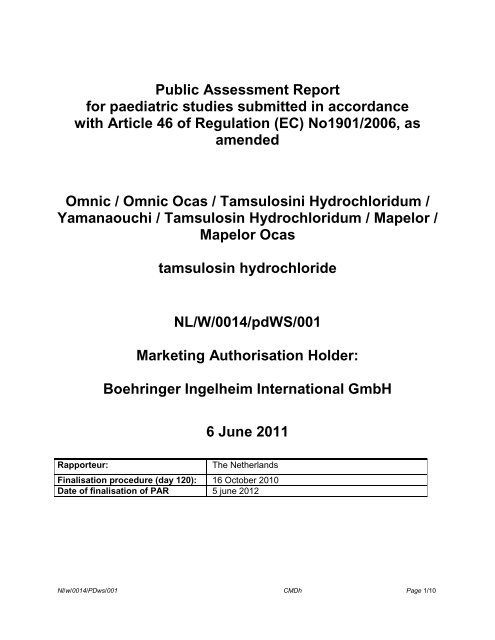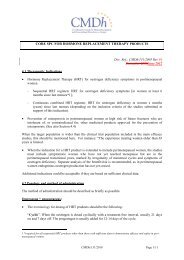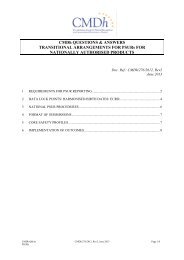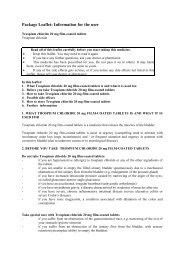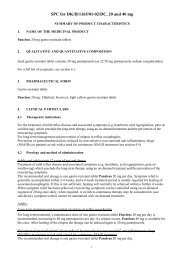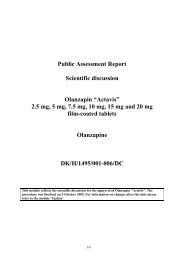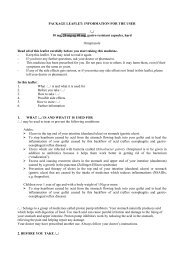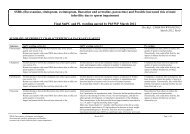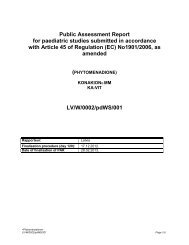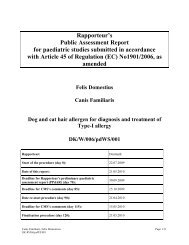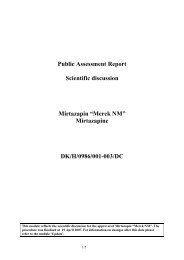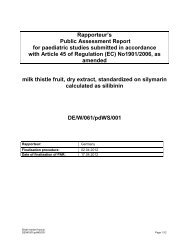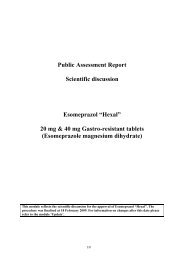Omnic and associated names (tamsulosin hydrochloride)
Omnic and associated names (tamsulosin hydrochloride)
Omnic and associated names (tamsulosin hydrochloride)
You also want an ePaper? Increase the reach of your titles
YUMPU automatically turns print PDFs into web optimized ePapers that Google loves.
Public Assessment Report<br />
for paediatric studies submitted in accordance<br />
with Article 46 of Regulation (EC) No1901/2006, as<br />
amended<br />
<strong>Omnic</strong> / <strong>Omnic</strong> Ocas / Tamsulosini Hydrochloridum /<br />
Yamanaouchi / Tamsulosin Hydrochloridum / Mapelor /<br />
Mapelor Ocas<br />
<strong>tamsulosin</strong> <strong>hydrochloride</strong><br />
NL/W/0014/pdWS/001<br />
Marketing Authorisation Holder:<br />
Boehringer Ingelheim International GmbH<br />
6 June 2011<br />
Rapporteur: The Netherl<strong>and</strong>s<br />
Finalisation procedure (day 120): 16 October 2010<br />
Date of finalisation of PAR 5 june 2012<br />
Nl/w/0014/PDws/001 CMDh Page 1/10
ADMINISTRATIVE INFORMATION<br />
Invented name of the medicinal<br />
product:<br />
INN (or common name) of the active<br />
substance(s):<br />
<strong>Omnic</strong>, <strong>Omnic</strong> Ocas, Tamsulosini Hydrochloridum<br />
Yamanaouchi, Tamsulosin Hydrochloridum ,<br />
Mapelor <strong>and</strong> Mapelor Ocas<br />
Tamsulosin <strong>hydrochloride</strong><br />
MAH: Boehringer Ingelheim International GmbH<br />
Currently approved Indication(s) Lower urinary tract symptoms (LUTS) <strong>associated</strong><br />
with benign prostatic hyperplasia (BPH).<br />
Pharmaco-therapeutic group<br />
(ATC Code):<br />
Pharmaceutical form(s) <strong>and</strong><br />
strength(s):<br />
G04CA02<br />
capsules (modified release), tablets (controlled<br />
release) <strong>and</strong> WOWTABs (orodispersible controlled<br />
release tablets)<br />
NL/W/0014PSws/001 Page 2/10
I. EXECUTIVE SUMMARY<br />
SmPC <strong>and</strong> PL changes are proposed in sections 4.2 <strong>and</strong> 5.1.<br />
Summary of outcome<br />
X Paediatric information clarified: section(s) 4.2, 5.1<br />
II. RECOMMENDATION<br />
The information obtained from the submitted studies is considered important for clinical practice. The<br />
conclusions of these two studies are in contrast with the general opinion reported in literature based on<br />
non comparative studies. It is therefore useful to include the results of these placebo controlled study in<br />
SPC section 4.2 <strong>and</strong> 5.1.<br />
III. INTRODUCTION<br />
On 2 November 2009 the MAH submitted 2 completed paediatric studies for <strong>tamsulosin</strong>, in accordance<br />
with Article 46 of Regulation (EC) No1901/2006, as amended, on medicinal products for paediatric use.<br />
A short critical expert overview has also been provided by the MAH.<br />
The MAH stated that the submitted paediatric studies do not influence the benefit risk for <strong>tamsulosin</strong> <strong>and</strong><br />
that there is no consequential regulatory action.<br />
IV. SCIENTIFIC DISCUSSION<br />
IV.1 Information on the pharmaceutical formulation used in the study(ies)<br />
Tamsulosin was provided in capsules with a strength of 0.025 mg , 0.1 mg, <strong>and</strong> 0.2 mg. The mode of<br />
administration was per os - Contents of 2 capsules sprinkled over a single teaspoonful (5 mL) of<br />
applesauce or yogurt. A spoonful of water was taken after ingesting the applesauce or yogurt.<br />
IV.2 Clinical aspects<br />
1. Introduction<br />
The MAH submitted 2 final reports for <strong>tamsulosin</strong>:<br />
� 527.51 A Phase IIb/III, multi-centre, double-blind, r<strong>and</strong>omised, placebo controlled, dose<br />
ranging study of <strong>tamsulosin</strong> <strong>hydrochloride</strong> (low, medium <strong>and</strong> high dose) as<br />
treatment in children with neuropathic bladder for three months<br />
� 527.66 An uncontrolled, open-label, titration, long-term safety (up to 12 months) <strong>and</strong><br />
efficacy study of <strong>tamsulosin</strong> <strong>hydrochloride</strong> in children with neuropathic bladder,<br />
with a r<strong>and</strong>omized pharmacokinetic sub-study investigating low, medium <strong>and</strong> high<br />
dose ranges<br />
NL/W/0014PSws/001 Page 3/10
2. Clinical studies<br />
The two submitted studies are described below.<br />
2.1 A Phase IIb/III, multi-centre, double-blind, r<strong>and</strong>omised, placebo-controlled, dose ranging<br />
study of <strong>tamsulosin</strong> <strong>hydrochloride</strong> (low, medium <strong>and</strong> high dose) as treatment in children with<br />
neuropathic bladder for three months. (527.51/ U09-3267-01)<br />
Objectives: To evaluate the efficacy <strong>and</strong> safety of a range of doses of <strong>tamsulosin</strong> <strong>hydrochloride</strong> as<br />
treatment in children with an elevated detrusor leak point pressure <strong>associated</strong> with a known neurological<br />
deficit (e.g., spina bifida).<br />
Methodology: Double-blind, r<strong>and</strong>omised, placebo controlled, dose ranging trial stratified by age (2-
geographic region. Hochberg procedure was used to adjust for multiple pair-wise testing against the<br />
placebo group. As a secondary analysis a test of trend in the proportion of responders across the dose<br />
levels was performed. Dichotomous secondary endpoints were analysed with the same method used for<br />
the primary endpoint. Continuous secondary endpoints were analysed using analysis of covariance with<br />
treatment variable <strong>and</strong> following covariates: age group, concomitant use of anti-cholinergic medication,<br />
geographic region <strong>and</strong> the baseline value for the continuous endpoint.<br />
Efficacy / clinical pharmacology results:<br />
LPP Response (OT): Of the 135 patients (FAS-LPP) who completed the study, 51 patients were LPP<br />
responders (LPP
Orthostatic Testing: The incidence of orthostatic hypotension was low for the placebo <strong>and</strong> <strong>tamsulosin</strong><br />
HCl patients. None were reported as AEs.<br />
Other endpoints: There were no clinically meaningful trends in clinical laboratory endpoints, hormonal<br />
assay results, visual acuity, <strong>and</strong> cognitive testing for patients on placebo or <strong>tamsulosin</strong> HCl, nor did there<br />
appear to be a trend among the <strong>tamsulosin</strong> HCl treatment groups.<br />
ECG assessments: No ECG findings were noted as clinically significant except for one ECG finding of<br />
mild sinus tachycardia that was reported as an AE in a high dose <strong>tamsulosin</strong> HCl patient.<br />
Conclusions: Tamsulosin HCl showed no statistically significant difference in efficacy from placebo in<br />
pediatric patients with neuropathic bladder based on the absence of statistical <strong>and</strong> clinical significance<br />
for all primary <strong>and</strong> secondary endpoints. The overall response rate for the primary endpoint in the<br />
placebo group was comparable to <strong>tamsulosin</strong> HCl response rates in low, medium, high dose groups,<br />
respectively. The child’s age group <strong>and</strong> use of anti-cholinergic medication at baseline were not<br />
<strong>associated</strong> with LPP response rates. No dose response trend was observed.<br />
Tamsulosin HCl was safe <strong>and</strong> well tolerated across all treatment groups. There were no new or<br />
unexpected adverse events observed. There was no dose response across safety parameters <strong>and</strong> there<br />
were few serious or related adverse events <strong>and</strong> their rates were similar across treatment groups.<br />
Efficacy outcomes of this trial indicate that there is no therapeutic value of <strong>tamsulosin</strong> HCl as a treatment<br />
for pediatric patients with elevated detrusor leak point pressure <strong>associated</strong> with a known neurological<br />
deficit.<br />
2.2 An uncontrolled, open-label, titration, long-term safety (up to 12 months) <strong>and</strong> efficacy<br />
study of <strong>tamsulosin</strong> <strong>hydrochloride</strong> in children with neuropathic bladder, with a r<strong>and</strong>omized<br />
pharmacokinetic sub-study investigating low, medium <strong>and</strong> high dose ranges (527.66/U09-3809-<br />
01).<br />
Objectives: To characterise the pharmacokinetic (PK) / pharmacodynamic (PD) profile <strong>and</strong> evaluate the<br />
safety <strong>and</strong> efficacy of <strong>tamsulosin</strong> <strong>hydrochloride</strong> in children with elevated detrusor leak point pressure<br />
<strong>associated</strong> with a known neurological disorder (e.g., spina bifida) for up to 12 months of treatment.<br />
The PK / PD results have been previously summarized <strong>and</strong> are provided in a separate report (U07-<br />
3384). PK <strong>and</strong> Denovo patients have been previously summarized <strong>and</strong> are provided in a separate report<br />
(U09-3250-01).<br />
This report summarizes results for Rollover patients (patients who entered Study 527.66 from Study<br />
527.51).<br />
Methodology: Open-label, uncontrolled, multicenter, safety study of patients who entered from the<br />
double-blind Study 527.51 (U09-3267-01). These patients were titrated to their individual efficacious<br />
dose level.<br />
No. of subjects:<br />
planned: Planned enrolled: 120; Planned entered: 100<br />
actual: Actual enrolled: 105; Actual entered: 96<br />
Patients from the 527.51 study were continued in this study as part of an open-label rollover; the<br />
numbers above represent the number of Rollover patients.<br />
Diagnosis <strong>and</strong> main criteria for inclusion:<br />
Children between 2 <strong>and</strong> 16 years of age with elevated detrusor leak point pressure <strong>associated</strong> with a<br />
known neurological disorder.<br />
dose: 0.025 mg, 0.05 mg, 0.1 mg, 0.2 mg <strong>and</strong> 0.4 mg<br />
NL/W/0014PSws/001 Page 6/10
Active treatment groups:<br />
Weight (kg) Tamsulosin HCl<br />
Low dose<br />
(0.001 – 0.002 mg/kg)<br />
<strong>tamsulosin</strong> HCl<br />
Medium dose<br />
(0.002 – 0.004 mg/kg)<br />
9.0 – 12.0 0.025 mg 0.05 mg<br />
12.5 – 25.0 0.025 mg 0.05 mg 0.1 mg<br />
25.1 – 50.0 0.05 mg 0.1 mg 0.2 mg<br />
50.1 – 100.0 0.1 mg 0.2 mg 0.4 mg<br />
Tamsulosin HCl<br />
High dose<br />
(0.004 – 0.008 mg/kg)<br />
mode of admin.: Per os. Content of capsule(s) sprinkled over a spoonful of apple sauce or yogurt (per<br />
Amendment No. 2) taken 30 minutes after breakfast<br />
Duration of treatment: Up to 12 months<br />
Criteria for evaluation:<br />
Efficacy / clinical pharmacology:<br />
Efficacy parameters:<br />
Given that the 527.66 trial was prematurely terminated, the analysis plan was modified since there was<br />
less data collected <strong>and</strong> analyzed. The following alternative endpoints were analyzed:<br />
Primary: response defined as patients who achieved a decrease in their detrusor leak point pressure<br />
(LPP) to less than 40 cm H2O based upon two confirmatory measurements at the last value on<br />
treatment <strong>and</strong> LPP measurements over time.<br />
Secondary: change from baseline in LPP; improvement or stabilization of hydronephrosis <strong>and</strong> / or<br />
hydroureter based upon ultrasound grading at the last value on treatment compared to baseline.<br />
Safety: Physical examination, vital signs measurements (blood pressure, pulse rate, respiration rate),<br />
orthostatic testing, electrocardiogram (ECG), st<strong>and</strong>ard laboratory measures, urinalysis, vision, cognitive<br />
testing <strong>and</strong> adverse events.<br />
Statistical methods: Since limited data was collected due to the premature termination of the trial, it<br />
was not feasible to analyze the efficacy <strong>and</strong> safety variables according to the protocol. Refer to Section<br />
9.8 for a detail description of the changes to the analysis plan.<br />
Descriptive statistics were used to summarize the efficacy <strong>and</strong> safety. The primary analysis of LPP<br />
responders included the Full Analysis Set of patients based on last value on treatment (FAS-LPP). All<br />
secondary endpoints were analyzed by last value on treatment.<br />
Results<br />
Efficacy: The Group D-Rollover portion of Study 527.66 was terminated early based on data from Study<br />
527.51 that showed lack of efficacy in reducing LPP to
Safety results: Adverse events: <strong>tamsulosin</strong> HCl treatment was well tolerated during the study; 44.8% of<br />
patients experienced adverse events during the study, all of which were mild to moderate in intensity.<br />
The most frequently occurring adverse events were urinary tract infection (18.8%), nasopharyngitis<br />
(8.3%), influenza (5.2%), <strong>and</strong> vomiting (5.2%). There was no apparent relationship between the<br />
incidence of these adverse events <strong>and</strong> the dose of <strong>tamsulosin</strong> HCl. These adverse events were not<br />
unexpected in this patient population <strong>and</strong> were consistent with previous findings for the PK <strong>and</strong> Denovo<br />
patients.<br />
A total of 3 (3.1%) patients had serious adverse events, none of which were considered related to<br />
<strong>tamsulosin</strong> HCl treatment; no deaths occurred during the study.<br />
Orthostatic testing: there were no reports of orthostatic hypotension during orthostatic testing or reports<br />
of hypotension.<br />
Clinical laboratory measures: There were no clinically meaningful trends in clinical hematology,<br />
chemistry, or urinary laboratory measures with <strong>tamsulosin</strong> HCl treatment.<br />
Cognitive measures: no clinically relevant deterioration in cognition measures was observed.<br />
Conclusions: The Group D-Rollover portion of Study 527.66 was terminated early based on data from<br />
placebo-controlled Study 527.51 that showed lack of efficacy in reducing LPP to
2.4 Conclusion on clinical safety<br />
The safety profile of <strong>tamsulosin</strong> was shown to be good in this population of children presenting with<br />
neuropathic bladder secondary to a known neurological disorder (e.g. spina bifida). The AEs that were<br />
reported were expected, with events such as urinary tract infection being common in this group of patients<br />
due to their inherent medical problems. The adverse events that were <strong>associated</strong> with <strong>tamsulosin</strong><br />
treatment e.g. orthostatic hypotension, were expected <strong>and</strong> are already reported as adverse drug reactions<br />
in the labeling for <strong>tamsulosin</strong> in adults patients being treated for BPH. No new safety concerns were<br />
raised from these 2 studies. Subgroup analysis did not show any differences that would require dose<br />
modifications, apart from the weight-based dosing scheme already implemented in these trials to<br />
appropriately control the exposure to <strong>tamsulosin</strong> in paediatric patients.<br />
3. Benefit-risk balance<br />
No unexpected or unlisted side effects were reported during the 2 studies. It therefore can be concluded<br />
that the safety profile in children is - in general terms - comparable with that known from the elderly patient<br />
population with BPH.<br />
Of more interest is the conclusion of the company that in children suffering with neuropathic bladder,<br />
treatment with <strong>tamsulosin</strong>e is ineffective. Although the results obtained are comparable with those<br />
reported in open, non-controlled studies from literature, this placebo controlled study could not distinguish<br />
between the results obtained with placebo <strong>and</strong> <strong>tamsulosin</strong> (in various strengths). This is the first indication<br />
that the use of <strong>tamsulosin</strong> is not effective in children with neuropathic bladder.<br />
The information obtained from the submitted studies is considered important for the conclusions of the<br />
studies are in contrast with the opinion found in literature. It is therefore useful to include the results of<br />
these placebo controlled study in section 4.2 <strong>and</strong> 5.1.<br />
V. MEMBER STATES OVERALL CONCLUSION AND<br />
RECOMMENDATION<br />
The information obtained from the submitted studies is considered important because the conclusions of<br />
the studies are in contrast with the opinion found in literature. It is therefore concluded to include the<br />
results of these placebo controlled study in section 4.2 <strong>and</strong> 5.1 (Annex I).<br />
The MAH requested to submit the type 1B variation for practical reasons after variation NL/W/0014/<br />
pdWS/001 is finalized.<br />
� Overall conclusion / Recommendation<br />
The RMS concluded to mention the results of the studies in the SPC. A few minor changes to the text<br />
were proposed by one of the member states. These were agreed by the Rapporteur <strong>and</strong> by the MAH.<br />
The proposal to submit the type 1B variation 30 days after the pending variation NL/W/0014/ pdWS/001 is<br />
finalized can be accepted. This applies for the product from both manufacturers.<br />
In the type 1B variation the patient leaflet should be amended as well.<br />
NL/W/0014PSws/001 Page 9/10
ANNEX I - Proposed Changes to the SPC <strong>and</strong> PIL<br />
SPC<br />
4.2 Posology<br />
Paediatric population<br />
The safety <strong>and</strong> efficacy of <strong>tamsulosin</strong>e in children


